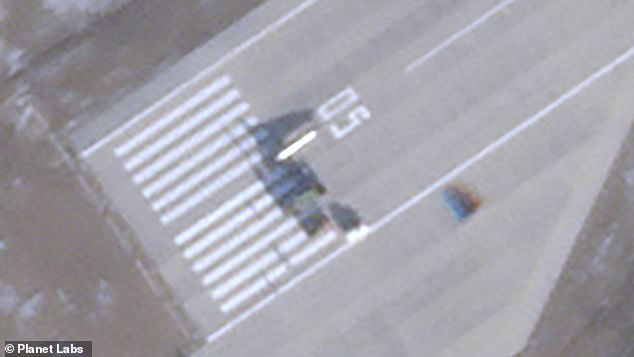A mystery object has been spotted at the end of a remote airstrip in China which has been linked to Beijing‘s space programme.
Satellite images show the long, white object alongside several smaller ones, which military analysts have suggested could be vehicles or support equipment.
The picture, taken on November 29 by Planet Labs and shared by The Warzone website, also shows a row of vehicles near the main facility, which has expanded significantly in recent years, most notably with a large new hangar.
The runway, located near the Lop Nur nuclear site, stretches more than three miles, making it one of the longest in the world.
While it is unclear what the object is, there has been speculation that it could be an aircraft, a worrying development amid China’s push for global dominance.
It is estimated to be around 32 feet in length – comparable to the U.S. Space Force’s two secretive X-37B mini-shuttles.
The X-37B – essentially a miniaturised robotic version of a space shuttle, is launched into space before using its own rockets and built in solar panel array to manoeuvre in orbit and deliver payloads to satellites before returning to Earth and landing on a runway.
NASA has kept many details of the X-37B under wraps, but the secretive space drone could easily be utilised to deploy weapons systems in space.

Satellite images show the long, white object alongside several smaller ones, which military analysts have suggested could be vehicles or support equipment

The picture, taken on November 29 by Planet Labs and shared by The Warzone website, also shows a row of vehicles near the main facility

The runway, located near the Lop Nur nuclear site, stretches more than three miles, making it one of the longest in the world
China has been increasing its space capabilities at an alarming rate over recent years.
In 2022, it conducted an apparently successful test of a nuclear-capable hypersonic glide vehicle and has developed an array of anti-satellite weaponry.
Beijing has also developed satellites capable of disabling Western orbital tech, with experts claiming that scientists have developed a science-fiction-inspired weapon that combines pulses of microwave radiation into a single powerful beam – just like the planet-destroying lasers shown in Star Wars.
In 2016 and 2021, the Chinese space program tested the capabilities of its Shijan 16 and 21 satellites. These are billed as ‘space debris neutralisation’ devices but analysts believe the tech likely has dual military use.
Sporting robotic arms, these satellites are capable of ‘grappling’ other satellites and ‘towing’ them out of geosynchronous orbit some 22,000 miles above the surface of the Earth.
This feat was demonstrated by Shijan-21 when it pulled China’s defunct Beidou-2 G2 navigation satellite more than 1,800 miles further out, leaving it in a ‘disposal orbit’ out of harm’s way of other satellites.
The capability has divided analysts who applauded China’s efforts to mitigate space debris, but also recognised the assets could easily be deployed in an offensive manner against enemy technology.
Such dual-use tech is also possessed by the US, which has conducted some seven test flights of a space drone based on the design of the iconic Space Shuttle.

The Chang’e 6 lunar probe and the Long March-5 Y8 carrier rocket combination sit atop the launch pad at the Wenchang Space Launch Site in Hainan province on May 3, 2024

Image taken from video animation at Beijing Aerospace Control Center on June 2, 2024
China also has a shuttle-like drone, the CSSHQ – though this device has only flown two missions and its capabilities are largely unknown.
China has also made headway with developing its claimed territory in space. In June, China landed an unmanned spacecraft on the far side of the moon.
The Chang’e-6 craft, equipped with an array of tools and its own launcher, touched down in a gigantic impact crater called the South Pole-Aitken Basin on the moon’s space-facing side.
The successful mission is China’s second on the far side of the moon, a region no other country has reached. The side of the moon perpetually facing away from the Earth is dotted with deep and dark craters, making communications and robotic landing operations more challenging.
Experts warned that China poses a major nuclear threat to the West after it rapidly expanded its atomic weapons arsenal.
Admiral Sir Tony Radakin, Chief of the Defence Staff, said the world was now entering a new ‘nuclear age’ – with China posing a more deadly threat than ever before.
In an alarming address to the Royal United Services Institute (RUSI) in London, Admiral Sir Tony said Britain was facing a new ‘world order’ shaped by its enemies and regional conflicts.
The military boss claimed Russia, China, Iran and North Korea all posed a danger, and highlighted Beijing as a particular challenge for the US.
For decades, the nuclear threat posed by China was not considered significant. But Beijing is now expanding its stockpile of nuclear weapons more rapidly than any other country.
It is feared that by 2030, the communist state will be on a par with the US and Russia and could soon have an apocalyptic arsenal of 1,000 nuclear warheads.
Speaking at RUSI’s annual Chief of the Defence Staff lecture, Adm Sir Tony said the world was ‘at the dawn of a third nuclear age’.







